Note: Your are not logged in. We can not keep your scores or track your progress unless you Register and Log In
Use of the Securement System With Logs
Packing requirements
- Logs must be solidly packed.
- Outer bottom logs must be in contact with and rest solidly against bunks, bolsters, stakes, or standards.
-
Each outside log on the side of a stack of logs must touch at least two bunks, bolsters, stakes, or standards. If one end of the log doesn't touch a stake:
- It must rest on other logs in a stable manner.
- It must extend beyond the stake, bunk, bolster, or standard.
- The center of the highest log on each side or end must be below the top of each stake, bunk, or standard.
There are two options for the upper logs that form the top of the load:
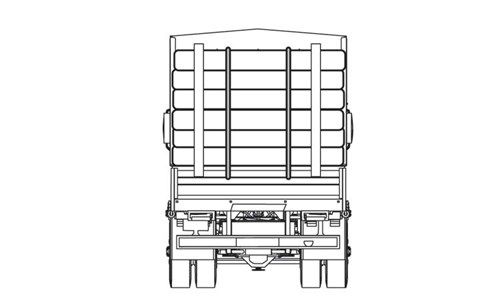
Either they must be crowned
Or each log that is not held in place by contact with other logs or stakes, bunks, or standards must be held in place by a tiedown.
Securement requirements
- Tighten tiedowns at initial loading.
- Do not tension beyond the tiedown's working load limit.
- Check the load and tiedowns at entry onto a public road, in addition to the intervals specified on page x. Adjust load and tiedowns as needed.
- Use additional tiedowns or securing devices when there is low friction between logs and they are likely to slip on each other (for example, logs are wet or coated with sawdust).
Vehicle Types
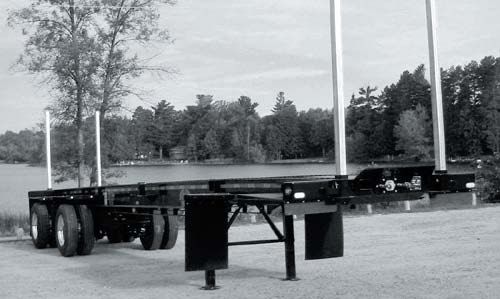

Special Circumstances: Securing Shortwood Logs Loaded Crosswise on Frame, Rail, and Flatbed Vehicles
Lower tier requirements
The end of a log in the lower tier must never extend more than 1/3 of the log's total length beyond the nearest supporting structure. This prevents tipping when the vehicle turns.
Tiedowns requirements
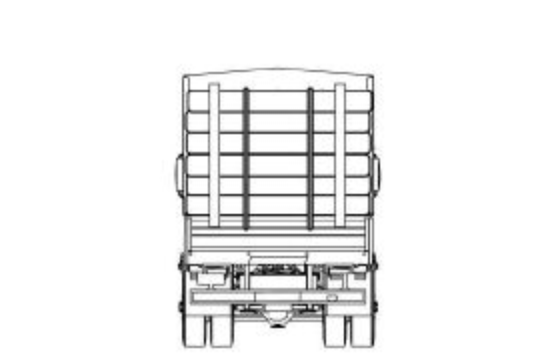
Use two tiedowns to secure one stack of shortwood loaded crosswise.
Attach the tiedowns to the vehicle frame at the front and rear of the load.
Position tiedowns approximately 1/3 and 2/3 of the length of the logs.
Requirements for dividing vehicles over 10m (33 ft)
Vehicles over 10 m (33 ft) must be equipped with center stakes, or comparable devices, to divide it into sections of equal length.
Each tiedown must:
- Secure the highest log on each side of the center stake.
- Be fastened below these logs.
Three securement options:
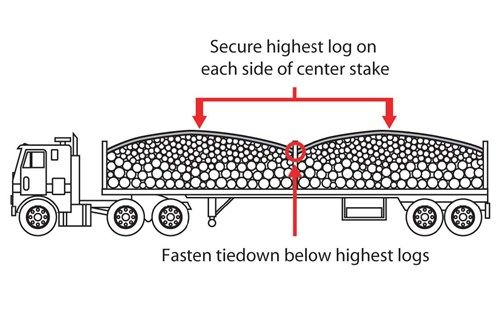
Option #1: Tiedowns may be fixed at each end and tensioned from the middle.
Option #2: Tiedowns may be fixed in the middle and tensioned from each end.
Tiedowns may pass through a pulley or equivalent device in the middle and tensioned from one end.
Stakes/structure and tiedowns requirements
Anchor any structure or stake that is being forced upward when the tiedowns are being tensioned.
Additional requirements securement for two stacks side-by-side
In addition to the requirements for shortwood loaded crosswise, load two stacks side-by-side so that:
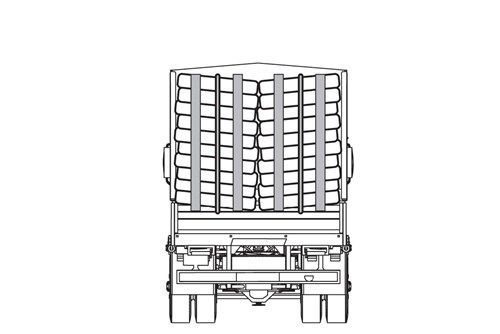
- There is no space between the stacks of logs.
- The outside of each stack is raised at least 2.5 cm (1 in) within 10 cm (4 in) of the end of the logs or from the side of the vehicle.
- The highest log is no more than 2.44 m (8 ft) above the deck.
- At least one tiedown is used lengthwise across each stack.
 Related Cargo Securement Terms That Every Driver Should Know:
Related Cargo Securement Terms That Every Driver Should Know:
-
Banding:
A strip of material that may be used to unitize articles and is tensioned and clamped or crimped back upon itself. (same as "Strapping")
-
Bell Pipe Concrete:
Pipe whose flanged end is of larger diameter than its barrel.
-
Bolster:
A crosswise load bearing structural component, particularly a part of a log bunk.
Multiple-Choice Questions:
What is bell pipe concrete?
- Pipe whose flanged end is of smaller diameter than its barrel.
- Pipe used to make concrete bells.
- Pipe whose flanged end is of larger diameter than its barrel.
- Concrete used to make bell pipe.
Bell Pipe Concrete:
Pipe whose flanged end is of larger diameter than its barrel.
Define 'bolster':
- An inflatable bag intended to fill otherwise empty space between articles of cargo, or between articles of cargo and the wall of the vehicle.
- A vertical barrier across the front of the deck of a vehicle to prevent forward movement of cargo.
- A structure, device, or another substantial article placed against or around an article to prevent horizontal movement of the article.
- A crosswise load bearing structural component, particularly a part of a log bunk.
Bolster:
A crosswise load bearing structural component, particularly a part of a log bunk.
How many tiedowns are required on a stack of shortwood loaded crosswise?
- It depends on the weight
- 3
- 2
- 1
Tiedowns requirements

Use two tiedowns to secure one stack of shortwood loaded crosswise.
Attach the tiedowns to the vehicle frame at the front and rear of the load.
Position tiedowns approximately 1/3 and 2/3 of the length of the logs.
As part of the log packing requirements:
- The center of the highest log on each side or end must be above the top of each stake, bunk, or standard.
- Outer bottom logs must be in contact with and rest solidly against bunks, bolsters, stakes, or standards.
- Each inside log on the side of a stack of logs must touch at least two bunks, bolsters, stakes, or standards.
- Logs must be loosely packed.
Packing requirements
- Logs must be solidly packed.
- Outer bottom logs must be in contact with and rest solidly against bunks, bolsters, stakes, or standards.
-
Each outside log on the side of a stack of logs must touch at least two bunks, bolsters, stakes, or standards. If one end of the log doesn't touch a stake:
- It must rest on other logs in a stable manner.
- It must extend beyond the stake, bunk, bolster, or standard.
- The center of the highest log on each side or end must be below the top of each stake, bunk, or standard.
All of the following are requirements for dividing vehicles over 33ft except:
- Each tiedown must secure the highest log on each side of the center stake.
- Vehicle must be divided by center stakes into sections of staggered length.
- Each tiedown must be fastened below the logs on each side of the center stake.
- Vehicle must be equipped with center stakes or comparable devices.
Requirements for dividing vehicles over 10m (33 ft)
Vehicles over 10 m (33 ft) must be equipped with center stakes, or comparable devices, to divide it into sections of equal length.
Each tiedown must:
- Secure the highest log on each side of the center stake.
- Be fastened below these logs.
Banding is:
- A device placed on the exposed edge of an article to distribute tiedown forces over a larger area of cargo than the tiedown itself, to protect the tie-down and/or cargo from damage, and to allow the tiedown to slide freely when being tensioned.
- A strip of material that may be used to unitize articles and is tensioned and clamped or crimped back upon itself. (same as "Strapping")
- A combination of securing devices which form an assembly that attaches cargo to, or restrains cargo on, a vehicle or trailer, and is attached to anchor point(s).
- Material used to fill a void between articles of cargo and the structure of the vehicle that has sufficient strength to prevent movement of the articles of cargo.
Banding:
A strip of material that may be used to unitize articles and is tensioned and clamped or crimped back upon itself. (same as "Strapping")
Requirements for securing two stacks of shortwood loaded side-by-side include:
- There is no space between the stacks of logs.
- The highest log is no more than 8 ft above the deck.
- At least one tiedown is used lengthwise across each stack.
- All of these are required.
Additional requirements securement for two stacks side-by-side
In addition to the requirements for shortwood loaded crosswise, load two stacks side-by-side so that:

- There is no space between the stacks of logs.
- The outside of each stack is raised at least 2.5 cm (1 in) within 10 cm (4 in) of the end of the logs or from the side of the vehicle.
- The highest log is no more than 2.44 m (8 ft) above the deck.
- At least one tiedown is used lengthwise across each stack.
Complete!
You can Return To The Table Of Contents







 TT On Facebook
TT On Facebook